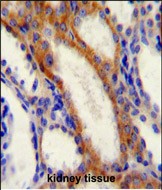STIM1 Antibody (C-term)
Affinity Purified Rabbit Polyclonal Antibody (Pab)
- 产品详情
- 文献引用 : 1
- 实验流程
- 背景知识
Application
| WB, IHC-P, E |
|---|---|
| Primary Accession | Q13586 |
| Other Accession | P70302, NP_003147.2 |
| Reactivity | Human |
| Predicted | Mouse |
| Host | Rabbit |
| Clonality | Polyclonal |
| Isotype | Rabbit IgG |
| Calculated MW | 77423 Da |
| Antigen Region | 509-538 aa |
| Gene ID | 6786 |
|---|---|
| Other Names | Stromal interaction molecule 1, STIM1, GOK |
| Target/Specificity | This STIM1 antibody is generated from rabbits immunized with a KLH conjugated synthetic peptide between 509-538 amino acids from the C-terminal region of human STIM1. |
| Dilution | WB~~1:1000 IHC-P~~1:100~500 E~~Use at an assay dependent concentration. |
| Format | Purified polyclonal antibody supplied in PBS with 0.09% (W/V) sodium azide. This antibody is purified through a protein A column, followed by peptide affinity purification. |
| Storage | Maintain refrigerated at 2-8°C for up to 2 weeks. For long term storage store at -20°C in small aliquots to prevent freeze-thaw cycles. |
| Precautions | STIM1 Antibody (C-term) is for research use only and not for use in diagnostic or therapeutic procedures. |
| Name | STIM1 |
|---|---|
| Synonyms | GOK {ECO:0000303|PubMed:9377559} |
| Function | Acts as a Ca(2+) sensor that gates two major inward rectifying Ca(2+) channels at the plasma membrane: Ca(2+) release- activated Ca(2+) (CRAC) channels and arachidonate-regulated Ca(2+)- selective (ARC) channels (PubMed:15866891, PubMed:16005298, PubMed:16208375, PubMed:16537481, PubMed:16733527, PubMed:16766533, PubMed:16807233, PubMed:18854159, PubMed:19182790, PubMed:19249086, PubMed:19622606, PubMed:19706554, PubMed:22464749, PubMed:24069340, PubMed:24351972, PubMed:24591628, PubMed:25326555, PubMed:26322679, PubMed:28219928, PubMed:32415068). Plays a role in mediating store- operated Ca(2+) entry (SOCE), a Ca(2+) influx following depletion of intracellular Ca(2+) stores. Upon Ca(2+) depletion, translocates from the endoplasmic reticulum to the plasma membrane where it activates CRAC channel pore-forming subunits ORA1, ORA2 and ORAI3 to generate sustained and oscillatory Ca(2+) entry (PubMed:16208375, PubMed:16537481, PubMed:32415068). Involved in enamel formation (PubMed:24621671). |
| Cellular Location | Cell membrane; Single-pass type I membrane protein. Endoplasmic reticulum membrane; Single-pass type I membrane protein. Cytoplasm, cytoskeleton. Sarcoplasmic reticulum. Note=Translocates from the endoplasmic reticulum to the cell membrane in response to a depletion of intracellular calcium and is detected at punctae corresponding to junctions between the endoplasmic reticulum and the cell membrane (PubMed:16005298, PubMed:16208375, PubMed:18854159, PubMed:19182790, PubMed:19249086). Associated with the microtubule network at the growing distal tip of microtubules (PubMed:19632184). Colocalizes with ORAI1 at the cell membrane (PubMed:27185316). Colocalizes preferentially with CASQ1 at endoplasmic reticulum in response to a depletion of intracellular calcium (PubMed:27185316) |
| Tissue Location | Ubiquitously expressed in various human primary cells and tumor cell lines. |
For Research Use Only. Not For Use In Diagnostic Procedures.

Provided below are standard protocols that you may find useful for product applications.
BACKGROUND
This gene encodes a type 1 transmembrane protein that mediates Ca2+ influx after depletion of intracellular Ca2+ stores by gating of store-operated Ca2+ influx channels (SOCs). It is one of several genes located in the imprinted gene domain of 11p15.5, an important tumor-suppressor gene region. Alterations in this region have been associated with the Beckwith-Wiedemann syndrome, Wilms tumor, rhabdomyosarcoma, adrenocrotical carcinoma, and lung, ovarian, and breast cancer. This gene may play a role in malignancies and disease that involve this region, as well as early hematopoiesis, by mediating attachment to stromal cells. This gene is oriented in a head-to-tail configuration with the ribonucleotide reductase 1 gene (RRM1), with the 3' end of this gene situated 1.6 kb from the 5' end of the RRM1 gene.
REFERENCES
Byun, M., et al. J. Exp. Med. 207(11):2307-2312(2010)
Park, C.Y., et al. Science 330(6000):101-105(2010)
Walsh, C.M., et al. Biochem. J. 430(3):453-460(2010)
Hawkins, B.J., et al. J. Cell Biol. 190(3):391-405(2010)
Woodward, O.M., et al. PLoS ONE 5 (8), E12305 (2010) :
终于等到您。ABCEPTA(百远生物)抗体产品。
点击下方“我要评价 ”按钮提交您的反馈信息,您的反馈和评价是我们最宝贵的财富之一,
我们将在1-3个工作日内处理您的反馈信息。
如有疑问,联系:0512-88856768 tech-china@abcepta.com.






















 癌症的基本特征包括细胞增殖、血管生成、迁移、凋亡逃避机制和细胞永生等。找到癌症发生过程中这些通路的关键标记物和对应的抗体用于检测至关重要。
癌症的基本特征包括细胞增殖、血管生成、迁移、凋亡逃避机制和细胞永生等。找到癌症发生过程中这些通路的关键标记物和对应的抗体用于检测至关重要。 为您推荐一个泛素化位点预测神器——泛素化分析工具,可以为您的蛋白的泛素化位点作出预测和评分。
为您推荐一个泛素化位点预测神器——泛素化分析工具,可以为您的蛋白的泛素化位点作出预测和评分。 细胞自噬受体图形绘图工具为你的蛋白的细胞受体结合位点作出预测和评分,识别结合到自噬通路中的蛋白是非常重要的,便于让我们理解自噬在正常生理、病理过程中的作用,如发育、细胞分化、神经退化性疾病、压力条件下、感染和癌症。
细胞自噬受体图形绘图工具为你的蛋白的细胞受体结合位点作出预测和评分,识别结合到自噬通路中的蛋白是非常重要的,便于让我们理解自噬在正常生理、病理过程中的作用,如发育、细胞分化、神经退化性疾病、压力条件下、感染和癌症。







